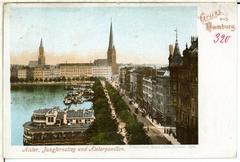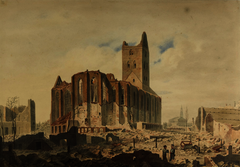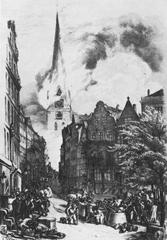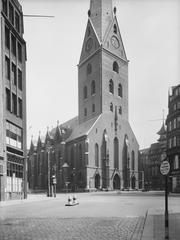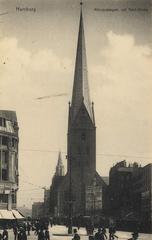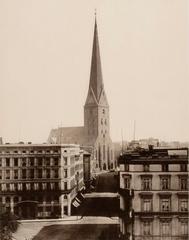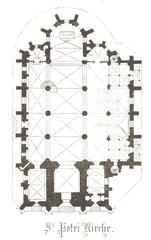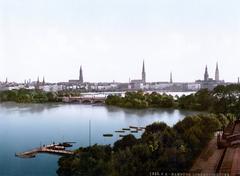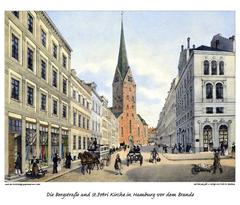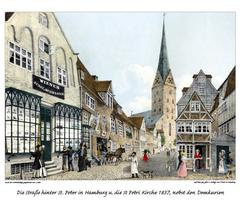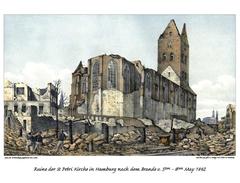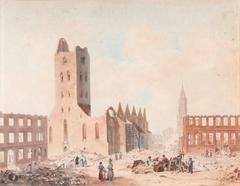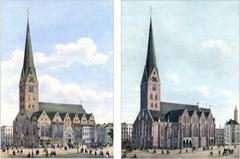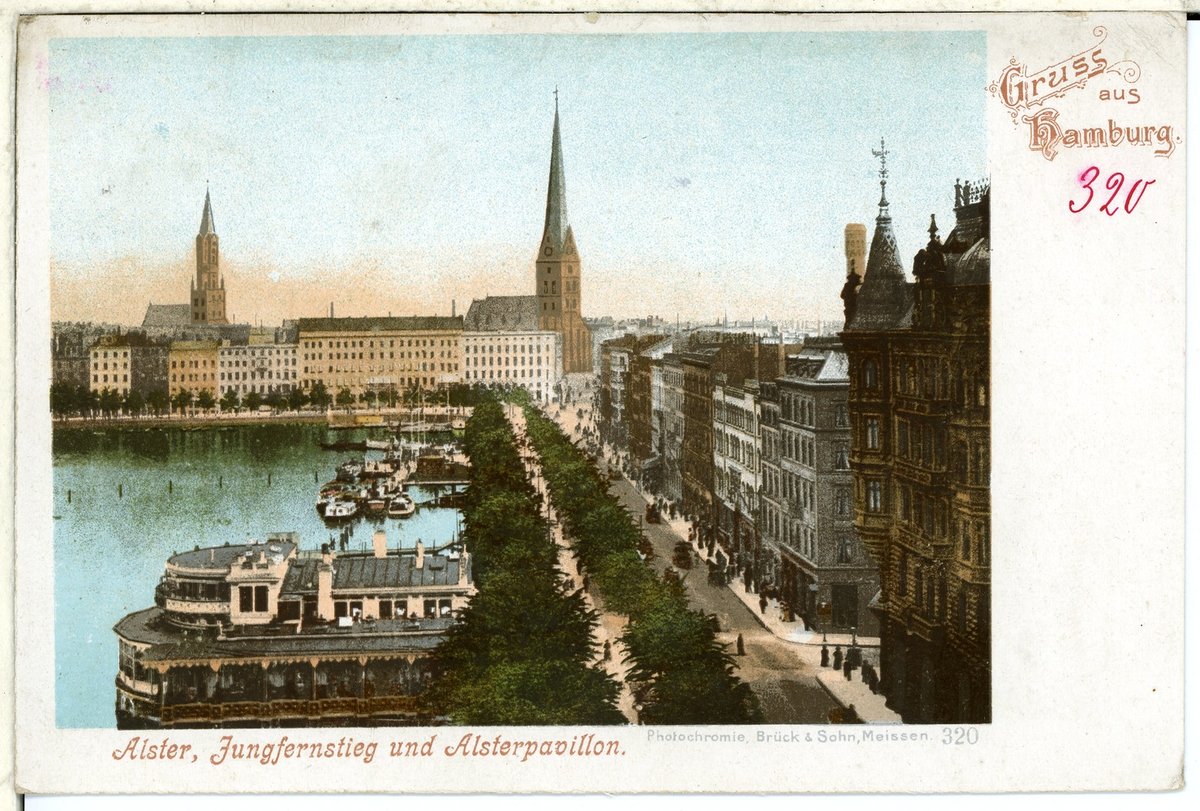
St. Peter’s Church Hamburg: Complete Visiting Guide, History, Tickets, and Travel Tips
Date: 14/06/2025
Introduction: Why Visit St. Peter’s Church in Hamburg?
St. Peter’s Church (St. Petri Kirche) is the oldest surviving parish church in Hamburg and a symbol of the city’s enduring spirit. Located in the heart of the Altstadt, it offers a fascinating blend of medieval heritage, stunning North German Brick Gothic architecture, priceless artistic treasures, and a vibrant role in Hamburg’s community life. From its first mention in 1195 to its dramatic reconstruction after the Great Fire of 1842, St. Peter’s Church has stood witness to centuries of history, war, and renewal.
Today, visitors can explore its soaring nave, admire rare medieval artworks like the 14th-century bronze lion-head door handles, and climb the 132-meter tower for unrivaled panoramic city views. The church remains a hub for music, exhibitions, and community events, making it an essential destination for anyone interested in Hamburg’s culture and history.
For the most up-to-date information, consult the official St. Peter’s Church website and Hamburg tourism resources.
Table of Contents
- Introduction
- Historical Overview
- Architectural and Artistic Highlights
- Visiting Information
- Nearby Attractions
- Practical Travel Tips
- Frequently Asked Questions (FAQ)
- Sources & Official Links
Historical Overview
Early Origins and Medieval Foundations
St. Peter’s Church stands near the original Hammaburg settlement, the birthplace of Hamburg. Evidence of a Christian place of worship dates back to the 11th century. The church’s first documented mention in 1195 as a “market cathedral” (ecclesia forensis) highlights its central role in the life of medieval Hamburg (twainsgeography.com).
Gothic Transformation and Artistic Heritage
Between 1310 and 1418, St. Peter’s was rebuilt in the Gothic style, with pointed arches, ribbed vaults, and a striking nave. The church’s most famous artworks include the 1342 bronze lion-head door handles—the oldest surviving pieces of art in Hamburg—and a mural of St. Ansgar from 1460 (twainsgeography.com). In the early 16th century, a second, even taller tower was added, cementing the church’s prominence.
Destruction, War, and Reconstruction
The church endured many challenges: the second tower was demolished in the early 19th century, and the building was used as a horse stable during the Napoleonic occupation. The Great Fire of 1842 devastated St. Peter’s, but valuable artifacts like the lion-head handles were salvaged (twainsgeography.com). The church was rebuilt in the original Gothic style by architects Alexis de Chateauneuf and Hermann Felsenfest, reopening in 1849. The current 132-meter tower, completed in 1878, is a defining feature of Hamburg’s skyline (hamburg.com).
During World War II, the church survived the bombings of 1943 with relatively minor damage, a testament to its resilience (hamburg.com).
Modern Era and Community Role
Today, St. Peter’s is one of Hamburg’s five main Lutheran churches. It is a center for worship, music, art exhibitions, and community outreach, reflecting the city’s cosmopolitan identity (hamburg.com).
Architectural and Artistic Highlights
Exterior and Structure
St. Peter’s is a classic example of North German Brick Gothic architecture. Its red brick façade, pointed arches, buttresses, and ornate west portal stand out in Hamburg’s cityscape (SpottingHistory). Above the portal is a statue of Archangel Michael, while the main entrance features the iconic bronze lion-head door handles from 1342 (Buddy the Traveling Monkey).
The 132-meter tower, with its copper spire, is one of the tallest in Hamburg. The viewing platform, accessed via 544 steps, is the highest publicly accessible church tower in the city.
Interior Layout and Artworks
Inside, visitors are greeted by a spacious nave, rib-vaulted ceilings adorned with over 500 gilded stars, and tall stained-glass windows that fill the church with light (Buddy the Traveling Monkey). The choir area features a statue by Bernt Notke of Archbishop Ansgar and the Marienkirche. Noteworthy artworks include:
- Bronze Lion-Head Door Handles (1342)
- Gothic Mural of Ansgar of Bremen (1460)
- Statue of Ansgar (late 1400s)
- 17th-century Paintings by Gottfried Libalt: “Jacob’s Dream” and “Christ’s Birth”
- Modern bronze sculpture of Dietrich Bonhoeffer
- Neo-Gothic representations of the Four Evangelists
The church also features a preserved portal gateway displayed at the Hamburg Museum, and a poignant painting, “Christmas 1813 in St. Peter’s,” commemorating citizens locked inside during the Napoleonic occupation (SpottingHistory).
Visiting Information
Opening Hours
- Monday – Saturday: 9:00 AM – 6:00 PM
- Sunday & Public Holidays: 12:00 PM – 6:00 PM
Check the official St. Peter’s Church website for possible changes during holidays or special events.
Tickets & Admission
- Main Church Entry: Free
- Tower Access: €4–€5 for adults; discounts for students, seniors, and groups
- Guided Tours: Additional fee; book online or on-site
Accessibility
- Main Entrance and Nave: Wheelchair accessible
- Tower: Stair access only; not suitable for visitors with reduced mobility
Guided Tours & Events
- Guided Tours: Available in German and English. Group and individual tours can be booked via the official website.
- Concerts & Exhibitions: The church hosts regular organ concerts, choral performances, art exhibitions, and community events (Kirchenmusik Hamburg).
The Petriturm (Tower) Experience
Climb 544 steps to reach the 123-meter-high viewing platform for breathtaking views of Hamburg’s city center, the Alster lakes, and the port. The climb is strenuous but rewarding, especially on clear days.
Nearby Attractions
- Hamburg City Hall (Rathaus)
- Speicherstadt Warehouse District
- St. Nicholas’ Church Ruins and Memorial
- Alster Lakes
- Mönckebergstraße Shopping District
All are within walking distance, making St. Peter’s a perfect starting point for exploring Hamburg’s historic core.
Practical Travel Tips
- Best Time to Visit: Weekday mornings for fewer crowds
- Photography: Allowed (no flash during services or events)
- Dress Code: Modest attire recommended
- Donations: Appreciated to support church upkeep
- Language: Information and tours available in both German and English
- Contact: Phone +49 40 325740-0 or [email protected]
- Location: Bei der Petrikirche 2, 20095 Hamburg. Nearest subway: Rathaus (U3 line)
For more travel tips and updates, download the Audiala app and follow the church’s official channels.
Frequently Asked Questions (FAQ)
Q: Are there entrance fees to visit St. Peter’s Church Hamburg?
A: Entry is free; the tower climb requires a ticket.
Q: What are the opening hours?
A: Monday-Saturday 9:00–18:00; Sundays/public holidays 12:00–18:00.
Q: Is St. Peter’s Church wheelchair accessible?
A: Yes, except for the tower.
Q: Are guided tours available in English?
A: Yes, bookable via the official website.
Q: Can I take photographs inside?
A: Yes, but avoid flash and respect ongoing services.
Q: How do I get there by public transport?
A: U-Bahn Rathaus (U3), several bus lines, or by foot from major city attractions.
Sources and Official Links for More Information
- St. Peter’s Church Hamburg: A Historic Landmark and Visitor’s Guide, Twain’s Geography
- Official Hamburg Tourism Website
- St. Peter’s Church Hamburg: Visiting Hours, Tickets & Historical Significance, Hamburg Tourism
- SpottingHistory: St. Peter’s Church Hamburg
- Buddy the Traveling Monkey: Best Churches in Hamburg
- Official St. Petri Website
Plan your visit to St. Peter’s Church Hamburg and experience the living history of one of the city’s most cherished landmarks. Download the Audiala app for guided tours, stay updated on events, and enjoy your journey through Hamburg’s rich heritage.
